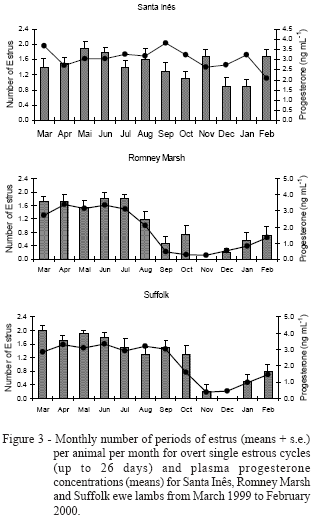The increased emphasis placed on lamb production in Brazil points to the need for a better knowledge of the annual pattern of reproductive activity in ewe lambs. This study evaluates the annual estrous activity pattern of hair and wool ewe lambs raised in southeast Brazil. Estrous characteristics were recorded for 12 months in ten Santa Inês and 21 Romney Marsh and Suffolk ewe lambs. Santa Inês ewe lambs exhibited a greater length of the normal estrous cycle (14 to 19 days) than Romney Marsh and Suffolk ewe lambs (17.0 ± 0.1 days vs. 16.5 ± 0.2 and 15.9 ± 0.2 days). All the ewe lambs presented a greater number of periods of estrus per animal per month for single estrous cycles (up to 26 days) during autumn and winter. During spring and summer there was a reduction of this number but this decline varied according to the breed. For Santa Inês ewe lambs the reduction was only significant in the summer. For wool ewe lambs the reduction was significant in both seasons but was more accentuated for Romney Marsh. The Romney Marsh ewe lambs had a more restricted breeding season than Suffolk and both presented optimal estrus activity in autumn and winter. Santa Inês ewe lambs had a continuous distribution of estrous cycles along the year, although presenting a reduction in the number of estrous periods in the summer. The ewe lambs of three breeds presented characteristics of sexual immaturity, like irregular estrous cycles and silent ovulations.
breeds; estrous cycle; sheep; subtropics; seasonality







